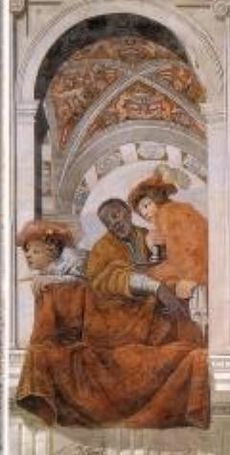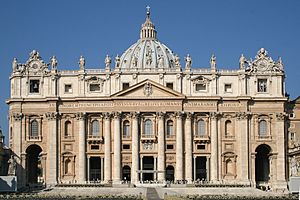Pope Paul V facts for kids
Quick facts for kids Pope Paul V |
|
|---|---|
| Bishop of Rome | |

Portrait of Pope Paul V by Caravaggio
(1605–1606, Galleria Borghese) |
|
| Church | Catholic Church |
| Papacy began | 16 May 1605 |
| Papacy ended | 28 January 1621 |
| Predecessor | Leo XI |
| Successor | Gregory XV |
| Orders | |
| Ordination | 20 October 1577 |
| Consecration | 27 May 1597 by Clement VIII |
| Created Cardinal | 5 June 1596 |
| Personal details | |
| Birth name | Camillo Borghese |
| Born | 17 September 1550 Rome, Papal States |
| Died | 28 January 1621 (aged 70) Rome, Papal States |
| Previous post |
|
| Motto | Absit nisi in te gloriari (Far, but in your glory) |
| Coat of arms |  |
| Other Popes named Paul | |
Pope Paul V (born Camillo Borghese) led the Catholic Church and ruled the Papal States from May 1605 until his death in January 1621. He was born on September 17, 1550, and passed away on January 28, 1621.
During his time as Pope, he met with the famous scientist Galileo Galilei. In 1611, Pope Paul V recognized Galileo's discoveries. Later, in 1616, he told Galileo that the idea of the Earth moving around the Sun (the Copernican theory) could not be taught as a proven fact. However, the Pope also promised Galileo that he would be safe from harm as long as Paul V was alive.
Contents
Early Life and Education
Camillo Borghese was born in Rome on September 17, 1550. His family, the Borgheses, originally came from Siena but had recently moved to Rome. He was the oldest of seven sons. His father, Marcantonio Borghese, was a lawyer. His mother, Flaminia Astalli, was a Roman noblewoman.
Camillo studied law carefully at universities in Perugia and Padua. He became a very skilled expert in church law.
Becoming a Cardinal
In June 1596, Camillo Borghese was made a Cardinal-Priest by Pope Clement VIII. He was given the church of Sant'Eusebio and became the Cardinal Vicar of Rome. This meant he was in charge of the Pope's spiritual duties in Rome.
He later chose other churches to be linked to his cardinal title, such as San Crisogono and Santi Giovanni e Paolo. Camillo stayed out of political groups and spent his free time studying his law books.
Pope Clement VIII also made him a Bishop in 1597 for the area of Iesi. Bishop Borghese kept this role until 1599.
His Time as Pope
Becoming Pope
When Pope Leo XI died in 1605, Cardinal Borghese was chosen as the new Pope. He was a good choice because he had stayed neutral in the disagreements between different groups.
He was known for being very strict and firm. He was more of a lawyer than a diplomat. He strongly defended the rights and special rules of the Church. One of his first actions was to send bishops who were living in Rome back to their own areas. This was because the Council of Trent had said that every bishop must live in his own diocese.
| Papal styles of Pope Paul V |
|
|---|---|
 |
|
| Reference style | His Holiness |
| Spoken style | Your Holiness |
| Religious style | Holy Father |
| Posthumous style | None |
Views on Science
Paul V met with Galileo Galilei in 1616. Before this meeting, a church leader named Cardinal Bellarmine had warned Galileo. Bellarmine, following the Pope's orders, told Galileo not to believe or defend the idea that the Earth goes around the Sun (Heliocentrism).
There was some debate about whether Galileo was also told not to teach these ideas at all. A letter from Bellarmine to Galileo only said that the heliocentric ideas could not be defended or strongly believed. This letter helped Galileo later defend himself against rumors.
Recognizing Holy People
Pope Paul V officially declared several people saints. He made Charles Borromeo a saint in 1610 and Frances of Rome a saint in 1608. He also recognized Pompejanus in 1615 and Cardinal Albert de Louvain in 1621.
He also beatified many individuals. This is a step before becoming a saint. Those he beatified included Ignatius of Loyola (1609), Philip Neri (1615), Teresa of Ávila (1614), Aloysius Gonzaga (1605), and Francis Xavier (1619).
Creating New Cardinals
The Pope appointed 60 new cardinals during his time in office. He made his own nephew, Scipione Borghese, a cardinal. This was a common practice at the time, known as nepotism, where family members were given important positions. He also named Alessandro Ludovisi as a cardinal, who later became the next Pope, Gregory XV.
Dealing with Other Countries
Disputes with Venice
Paul V strongly believed that the Church should have special powers and rules. This led to arguments with governments in different countries. One major disagreement was with Venice. Venice passed laws that the Pope did not like. One law stopped the Church from buying land without permission. Another said that new churches needed the government's approval.
Venice also arrested two priests accused of serious crimes. The Pope demanded that the priests be released to the Church. He said they should not be judged by the government. When Venice refused, the Pope threatened to punish the city by placing an interdict on it. An interdict meant that many church services and sacraments would stop in Venice.
A lawyer from Venice, Paolo Sarpi, argued strongly against the Pope. He said that the Pope should not interfere in government matters. In April 1606, the Pope officially punished Venice and placed the interdict on the city. However, most of the Catholic clergy in Venice sided with their city. They continued to hold church services.
After about a year, France and Spain helped to settle the disagreement. Venice agreed to act with its "usual piety" but did not change its laws. The Pope then removed his punishment.
Relations with England
Pope Paul V's strong Catholic policies made things difficult for moderate Catholics in England. His letter to King James I in 1606 was sent three years late. It also mentioned the Gunpowder Plot, a plan to blow up the King and Parliament. This made the Pope's cause unpopular in England, as some believed papal agents were involved.
The Pope asked King James not to punish innocent Catholics for the actions of a few. He also promised to tell all Catholics to be loyal to the King, as long as it did not go against God's honor. However, King James demanded an oath of allegiance from his subjects. This oath contained parts that Catholics at the time could not agree to. The Pope officially condemned this oath in 1606. This caused divisions among English Catholics.
Relations with Japan

Japanese painting, 17th century.
In November 1615, Pope Paul V welcomed a special group from Japan. This group was led by the Japanese samurai Hasekura Tsunenaga.
Hasekura gave the Pope a letter from a Japanese leader, Date Masamune. The letter asked for a trade agreement between Japan and New Spain (parts of North America). It also asked for Christian missionaries to be sent to Japan. The Pope agreed to send missionaries. However, he left the decision about trade to the King of Spain.

Building Projects
In Rome, Pope Paul V helped pay for the completion of St. Peter's Basilica. He also improved the Vatican Library. He restored an old Roman aqueduct called the Aqua Traiana, which was renamed Acqua Paola after him. This aqueduct brought water to parts of Rome on the right side of the Tiber River.
Like many Popes of his time, he was accused of nepotism. His nephew, Scipione Borghese, gained a lot of power and helped the Borghese family rise in importance. Paul V also started the Bank of the Holy Spirit in 1605.
Death
Pope Paul V died on January 28, 1621, from a stroke at the Quirinal Palace in Rome. He had been sick for over three months after having several strokes. He was followed as Pope by Pope Gregory XV.
See also
 In Spanish: Paulo V para niños
In Spanish: Paulo V para niños
- Borghese
- Cardinals created by Paul V
- Flight of the Earls



